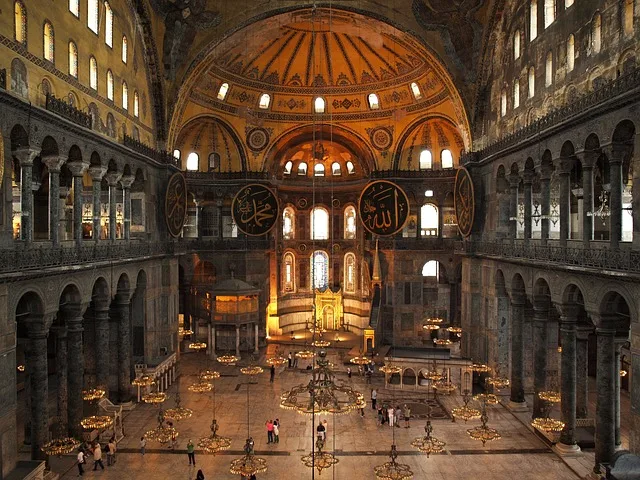Constructed in the 6th century, the Church of Saint Sophia was once the largest cathedral in the world, a true symbol of the Byzantine Empire’s power and prestige. Picture this: a space so grand that it could hold thousands of worshippers, all gathered under a magnificent dome that creates an ethereal atmosphere. The way light filters through the windows, casting a warm glow on the marble floors, is nothing short of magical.
But it’s not just the size that leaves you in awe; it’s the details. The mosaics, with their vibrant colors and intricate designs, tell tales of saints and biblical stories, inviting you to pause and reflect. Each piece is like a window into the past, revealing the deep spiritual significance that this church held for centuries.
And let’s not forget the architectural brilliance! The innovative use of arches and domes was revolutionary, influencing countless structures that followed. It’s as if the architects were playing a game of balance, creating a space that feels both grounded and soaring.
Visiting the Church of Saint Sophia is more than just a sightseeing trip; it’s an experience that connects you to history, art, and spirituality in a way that few places can. So, are you ready to explore this stunning monument and uncover the stories etched in its walls?
Unveiling the Splendor: The Architectural Marvel of the Church of Saint Sophia
The Church of Saint Sophia, often referred to as Hagia Sophia, is a stunning blend of Byzantine and Ottoman architecture. Picture this: massive columns that stand like ancient sentinels, each one telling tales of emperors and empires. The light filtering through the stained glass creates a dance of colors on the marble floors, making you feel as if you’ve stepped into a dream. Isn’t it fascinating how a structure can evoke such emotions?
As you wander through its vast halls, you can’t help but marvel at the craftsmanship. The dome, with its innovative design, seems to float above you, defying gravity. It’s like a giant crown, symbolizing the glory of a bygone era. And those mosaics? They’re not just decorations; they’re windows into the past, showcasing the rich tapestry of religious and cultural influences that have shaped this magnificent space.
Visiting the Church of Saint Sophia is more than just a sightseeing trip; it’s an experience that resonates deep within. It’s a reminder of human creativity and the power of faith, all wrapped up in one breathtaking package. So, if you ever find yourself in Istanbul, don’t just pass by—take a moment to soak in the splendor of this architectural wonder. You’ll leave with a piece of history etched in your heart.
From Byzantium to Modernity: The Enduring Legacy of Saint Sophia’s Architecture
Saint Sophia’s architecture is a brilliant blend of innovation and tradition. The massive dome, often described as floating, was a game-changer in its time. It’s like the architectural equivalent of a magician pulling a rabbit out of a hat! This design not only influenced Byzantine architecture but also left a lasting mark on the Renaissance and beyond. Can you believe that structures like the Florence Cathedral and even the Taj Mahal drew inspiration from this ancient wonder?
But it’s not just about the physical structure; it’s about the emotions it evokes. When you step inside, the light filtering through the mosaics creates a kaleidoscope of colors that dance on the walls. It’s as if the building itself is alive, breathing in the stories of the countless souls who have walked through its doors. The intricate details, from the marble floors to the ornate columns, tell tales of artistry and devotion that transcend time.
A Journey Through Time: Exploring the Byzantine Brilliance of the Church of Saint Sophia
As you approach the Church, the sheer size and grandeur take your breath away. It’s like standing before a giant that has witnessed centuries of change. The massive dome, soaring high above, feels like a celestial umbrella, inviting you to ponder the mysteries of the universe. Can you imagine the artisans and architects who poured their hearts into creating this masterpiece? Their dedication is palpable in every intricate mosaic and marble column.
Once inside, the atmosphere shifts. The soft glow of light filtering through the stained glass creates a magical ambiance, almost as if the walls are alive with stories of emperors and empresses. You can almost hear the echoes of ancient chants that once filled the air. It’s a place where spirituality and artistry intertwine, making you feel both small and significant at the same time.

But what truly sets the Church of Saint Sophia apart is its ability to adapt. From a cathedral to a mosque and now a museum, it has embraced change while retaining its essence. Isn’t that a beautiful metaphor for life? Just like this iconic structure, we too can evolve while holding onto our roots. So, as you wander through this architectural wonder, let yourself be swept away by the tales of resilience and brilliance that have stood the test of time.
Saint Sophia: The Crown Jewel of Byzantine Architecture and Its Cultural Significance
What makes Saint Sophia so special? For starters, its massive dome seems to float effortlessly above the nave, creating an ethereal atmosphere that leaves visitors in awe. It’s like stepping into a dream where the heavens meet the earth. The intricate mosaics, adorned with gold and vibrant colors, depict religious figures and scenes that have inspired countless generations. Each tile is a piece of art, whispering secrets of faith and devotion.

But it’s not just about the aesthetics. Saint Sophia symbolizes the fusion of cultures—Christianity and Islam—reflecting the complex history of the region. It’s a place where East meets West, where different beliefs coexist, much like a vibrant tapestry woven from diverse threads. This cultural significance resonates deeply, reminding us of the power of architecture to bridge divides and foster understanding.
Frequently Asked Questions
Can visitors access the Church of Saint Sophia today?
Visitors can access the Church of Saint Sophia, but it’s important to check current visiting hours and any restrictions that may apply. Entry may be subject to specific guidelines, so it’s advisable to verify details before planning your visit.
What are the key events in the history of the Church of Saint Sophia?
The Church of Saint Sophia has a rich history marked by significant events, including its construction in the 6th century under Emperor Justinian I, its role as a central place of worship in the Byzantine Empire, and its conversion into a mosque after the Ottoman conquest in 1453. It was later secularized and transformed into a museum in the 20th century, reflecting its diverse cultural and religious significance over the centuries.
How has the Church of Saint Sophia influenced Byzantine architecture?
The Church of Saint Sophia is a pivotal example of Byzantine architecture, showcasing innovative design elements such as its massive dome and extensive use of mosaics. Its architectural features influenced the development of churches throughout the Byzantine Empire, setting a standard for future religious structures. The integration of light and space in its design has inspired countless architects, making it a cornerstone of Byzantine architectural heritage.
What architectural features define the Church of Saint Sophia?
The Church of Saint Sophia is characterized by its grand dome, which symbolizes the heavens, and its use of large, arched windows that allow natural light to illuminate the interior. The structure features intricate mosaics and frescoes that depict religious themes, along with a cruciform layout that enhances its spiritual significance. The use of columns and a harmonious blend of Byzantine and Roman architectural elements further define its unique style.
What is the historical significance of the Church of Saint Sophia?
The Church of Saint Sophia is a landmark of Byzantine architecture and a symbol of the Eastern Orthodox Church. Built in the 6th century, it served as a cathedral for nearly 1,000 years and played a crucial role in the religious and political life of the Byzantine Empire. Its innovative design influenced the development of church architecture in both the East and West. Today, it stands as a UNESCO World Heritage site, reflecting the rich history and cultural heritage of Istanbul.

